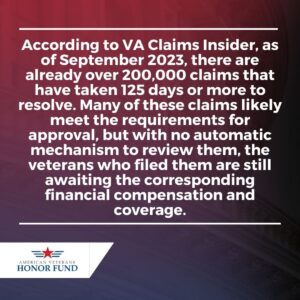Starting in June 2023, the Department of Veterans Affairs (VA) reported a significant backlog with their benefits claims. Initial estimates pointed the ongoing delays may affect up to 730,000 to 826,261 claims, and are expected to peak in 2024.
According to VA Claims Insider, as of September 2023, there are already over 200,000 claims that have taken 125 days or more to resolve. Many of these claims likely meet the requirements for approval, but with no automatic mechanism to review them, the veterans who filed them are still awaiting the corresponding financial compensation and coverage.
What’s Being Delayed at the VA?
Most of the backlogged claims are related to the PACT (Promise to Address Comprehensive Toxins) Act, which expands both health coverage and benefits payouts related to exposure to toxic substances, such as burn pits, mustard gas, or Agent Orange.
The PACT Act brought about a predictable windfall of claim applications since its approval in August 2022. However, as the paperwork continues to pile, the backlog is now also delaying other routine disability claims.
What’s Behind the Department of Veterans Affairs Backlog?
The first and most obvious factor in this backlog is the rush of applications following the approval of the PACT Act. As we originally reported a few months ago, the PACT Act expanded the list of “presumed conditions” that would entitle soldiers and veterans to receive full coverage. Veterans who had previously filed claims for these conditions, and who had been denied, were encouraged to file new claims.

The rush of applications from those who served in Iraq and Afghanistan was, up to a certain point, predictable. However, two other important factors are aggravating the Department of Veterans Affairs backlog.
Outdated technology and paper files
The world’s ability to deal with digital applications and digitized records advanced by leaps and bounds over the past five years. However, these new technologies have not reached many offices within the VA. According to Rep. Matt Rosendale (R-Montana), the VA’s current automation capacity is “closer to the State-of-the-Art of the 1990s.”
Technology problems include ongoing issues with the cloud system used to track claim items, as well as issues referring claimants to the right providers so they can get a physical exam. This step is crucial, as it provides an objective measure of each veteran’s degree of disability – and no money can be paid without it.
Ongoing staffing shortages
Recruiting and retaining talent is a recurrent headache for all sorts of companies. But for a Federal Agency, which often has salaries below the industry average, recruiting and retaining top-level talent can be very difficult.
VA facilities have long complained about staffing shortages. This factor is also impacting the VA’s ability to improve its technology use: before adopting any new system, the VA needs to train its existing staff on its use. While employees become proficient with their new tools, they can expect a temporary dip in productivity. However, the current backlog leaves them with no breathing room to train or improve their protocols.
Is There an End in Sight?
As the number of pending claims reaches its highest peak since 2012, the natural question for many vets is “What can I do about it?”
The easiest solution may be to simply wait until the surge has ended. However, current predictions point out that the backlog may last well into 2024. For many vets, the prospect of waiting six months or more just puts their families in a difficult position.
It is time for society as a whole to come together and help our military veterans. Support and elect candidates who will help the VA modernize. It’s the least we can do for them!


